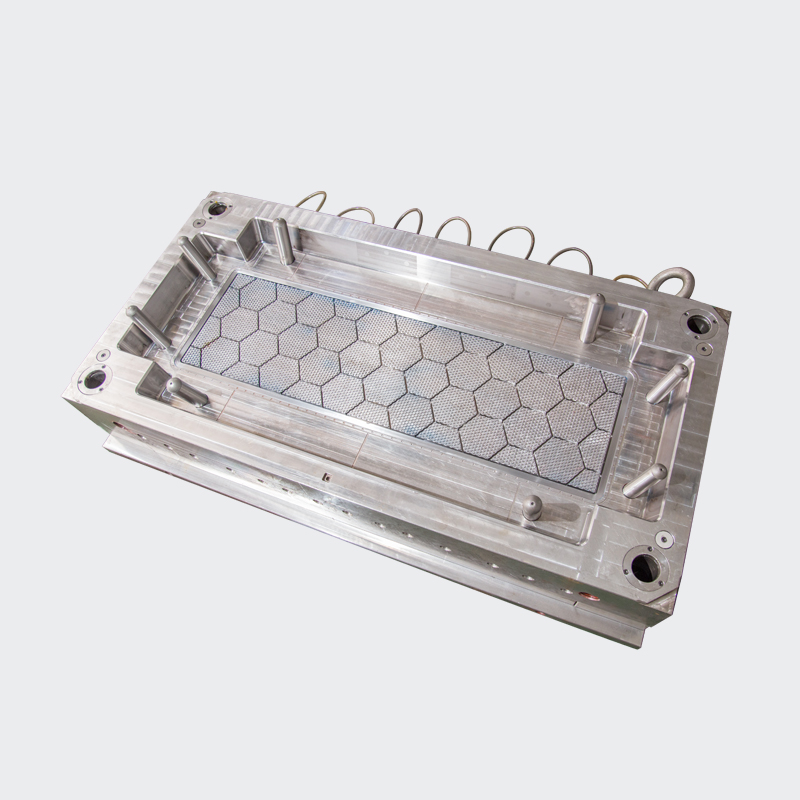
CRATE MOULD
Product Size:800*360*180
Mold size:1100*700*850
Mold making process
1. Accept the letter of assignment
The task of forming plastic parts is usually put forward by the part designer, and its contents are as follows:
1. The formal drawing of the finished part after examination and approval, and indicate the grade and transparency of plastic.
2. Plastic parts specifications or technical requirements.
3. Production output.
4. Samples of plastic parts.
Generally, the mold design task book is proposed by the plastics craftsman based on the task of molding plastic parts. The mold designer designs the mold based on the molding plastics task book and mold design task book.
2. Collect, analyze, and digest raw data
Collect and sort out relevant design information, molding technology, molding equipment, machining and special processing data for use in designing molds.
1. Digest the drawing of the plastic part, understand the purpose of the part, analyze the technical requirements such as the processability and dimensional accuracy of the plastic part. For example, what are the requirements for the appearance, color transparency, and performance of plastic parts, whether the geometry, slope, and inserts of the plastic parts are reasonable, the allowable degree of molding defects such as weld marks, shrinkage holes, and whether there are coatings? Post-processing such as assembly, electroplating, gluing, drilling, etc. Select the size with the highest dimensional accuracy of plastic parts for analysis, and see if the estimated forming tolerance is lower than the tolerance of the plastic part, and whether it can form a satisfactory plastic part. In addition, you need to understand the plasticization and molding process parameters of plastics.
2. Digest the process data and analyze whether the molding methods, equipment models, material specifications, mold structure types and other requirements set out in the process task book are appropriate and can be implemented.
The molding material should meet the strength requirements of plastic parts, and have good fluidity, uniformity, isotropy, and thermal stability. According to the use of plastic parts, the molding material should meet the requirements of dyeing, metal plating conditions, decorative properties, necessary elasticity and plasticity, transparency or opposite reflection properties, adhesiveness or weldability.
3. Determine the molding method
Direct pressure method, casting method or injection method.
4.Select molding equipment
Molds are made according to the type of molding equipment, so you must be familiar with the performance, specifications, and characteristics of various molding equipment. For example, for an injection machine, the following should be understood in terms of specifications: injection capacity, clamping pressure, injection pressure, mold installation size, ejector and size, nozzle hole diameter and nozzle spherical radius, gate sleeve positioning ring size, The maximum and minimum thickness of the mold, the stroke of the template, etc., see the relevant parameters for details.
It is necessary to initially estimate the mold dimensions and determine whether the mold can be installed and used on the selected injection machine.
5. Specific structural scheme
(1) Determine the mold type
Such as pressing molds (open, semi-closed, closed), casting molds, injection molds, etc.
(2) Determine the main structure of the mold type
Choosing the ideal mold structure is to determine the necessary molding equipment and the ideal number of cavities. Under absolutely reliable conditions, the work of the mold itself can meet the technical and economic requirements of the plastic part. The technical requirements for plastic parts are to ensure the geometry, surface finish and dimensional accuracy of plastic parts. The production economic requirement is to make the cost of plastic parts low, the production efficiency high, the mold can work continuously, the service life is long, and the labor is saved.
Third, there are many factors that affect the mold structure and the individual system of the mold, which are very complicated:
1. Cavity layout. According to the geometrical characteristics of plastic parts, dimensional accuracy requirements, batch size, mold manufacturing ease, mold cost, etc., determine the number of cavities and their arrangement.
For injection molds, the precision of plastic parts is grades 3 and 3a, the weight is 5 grams, the hardened casting system is used, and the number of cavities is 4-6; the plastic parts are of general precision (grade 4-5), and the molding The material is a local crystalline material, the number of cavities can be 16-20; the weight of plastic parts is 12-16 grams, the number of cavities is 8-12; and the number of cavities for plastic parts weighing 50-100 g 4-8. The recommended number of cavities for amorphous plastic parts is 24-48, 16-32 and 6-10. When the weight of plastic parts continues to increase, multi-cavity molds are rarely used. For plastic parts with 7-9 grade accuracy, the maximum number of cavities is increased to 50% compared to the 4-5 grade plastics indicated.
2. Determine the parting plane. The location of the parting surface should be conducive to mold processing, exhaust, demolding and molding operations, and the surface quality of plastic parts.
3. Determine the gating system (the shape, position, and size of the main runner, the runner, and the gate) and the exhaust system (the method of exhaust, the position and size of the exhaust tank).
4. Select the ejection method (ejector, ejector, push plate, combined ejection), determine the undercut processing method and core extraction method.
5. Decide the cooling and heating method, the shape and position of the heating and cooling grooves, and the installation location of the heating element.
Comments
Post a Comment